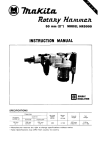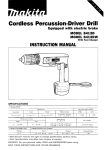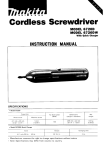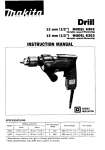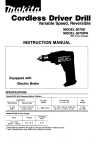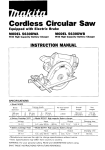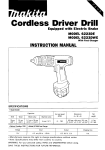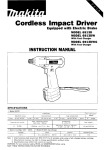Download Makita 8411DW Instruction manual
Transcript
Cordless Hammer Drill Equipped with electric brake MODEL 8411D MODEL 8411DW With Fast Charger INSTRUCTION MANUAL No load speed ( R P M ) Capacities Steel Wood 1 0 mm ( 3 / 8 ” ) 2 1 mm I 1 3 / 1 6 ” ) 0 ~ 12,700 Voltage 0 ~ Wood s c r e w 4,100 71;4m: ~~~~1~~ High Concrete 1 0 mm ( 3 / 8 ” ) 0 2 7 3 mm x 7 9 mm x 2 2 0 mm 110-3/4” x 3 - 1 / 8 ” x 8 - 5 / 8 ” ) Input output Manufacturer reserves t h e right t o change specifications w i t h o u t notice. Note: Specifications may differ from country t o country. ~ LOW 1,150 0 -- 370 1 . 8 7 k g (4 2 I b s ) Charging time IMPORTANT SAFETY INSTRUCTI0NS (For All Tools) WARNING: WHEN USING ELECTRIC TOOLS, BASIC SAFETY PRECAUTIONS SHOULD ALWAYS BE FOLLOWED TO REDUCE THE RISK OF FIRE, ELECTRIC SHOCK, AND PERSONAL INJURY, INCLUDING THE FOLLOWING: READ ALL INSTRUCTIONS. 1. KEEP WORK AREA CLEAN. Cluttered areas and benches invite injuries. 2. CONSIDER WORK AREA ENVIRONMENT. Don't use power tools in damp or wet locations.*Keep work area well lit. Don't expose power tools t o rain. Don't use tool in presence of flammable liquids or gases. 3. KEEP CHILDREN AWAY. All visitors should be kept away from work area. Don't let visitors contact tool or extension cord. 4.STORE IDLE TOOLS. When not in use, tools should be stored in dry, and high or locked-up place - out of reach of children. 5 . DON'T FORCE TOOL. It will do the job better and safer at the rate for which it was intended. 6. USE RIGHT TOOL. Don't force small tool or attachment t o do the job of a heavy-duty tool. Don't use tool for purpose not intended. 7 . DRESS PROPERLY. Don't wear loose clothing or jewelry. They can be caught in moving parts. Rubber gloves and non-skid footwear are recommended when working outdoors. Wear protective hair covering t o contain long hair. 8.USE SAFETY GLASSES. Also use face or dust mask if cutting operation is dusty. 9.DON'T ABUSE CORD. Never carry tool by cord or yank it t o disconnect from receptacle. Keep cord from heat, oil, and sharp edges. IO. SECURE WORK. Use clamps or a vise t o hold work. It's safer than using your hand and it frees both hands t o operate tool. 11. DON'T OVERREACH. Keep proper footing and balance at all times. 12. MAINTAIN TOOLS WITH CARE. Keep tools sharp and clean for better and safer performance. Follow instructions for lubricating and changing accessories. Inspect tool cords periodically and if damaged, have repaired by authorized service facility. Inspect extension cords periodically and replace if damaged. Keep handles dry, clean, and free from oil and grease. 13. DISCONNECT TOOLS. When not in use, before servicing, and when changing accessories, such as blades, bits, cutters. 2 14. REMOVE ADJUSTING KEYS AND WRENCHES. Form habit of checking t o see that keys and adjusting wrenches are removed from tool before turning it on. 15. AVOID UNINTENTIONAL STARTING. Don’t carry plugged-in tool with finger on switch. Be sure switch is OFF when plugging in. 16. OUTDOOR USE EXTENSION CORDS. When tool is used outdoors, use only extension cords intended for use outdoors and so marked. 17. STAY ALERT. Watch what you are doing, use common sense. Don’t operate tool when you are tired. 18. CHECK DAMAGED PARTS. Before further use of the tool, a guard or other part that is damaged should be carefully checked t o determine that it will operate properly and perform its intended function. Check for alignment of moving parts, binding of moving parts, breakage of parts, mounting, and any other conditions that may affect its operation. A guard or other part that is damaged should be properly repaired or replaced by an authorized service center unless otherwise indicated elsewhere in this instruction manual. Have defective switches replaced by authorized service center. Don’t use tool if switch does not turn it on and off. 19. GUARD AGAINST ELECTRIC SHOCK. Prevent body contact with grounded surfaces. For example; pipes, radiators, ranges, refrigerator enclosures. 20. REPLACEMENT PARTS. When servicing, use only identical replacement parts. VOLTAGE WARNING: Before connecting the tool t o a power source (receptacle, outlet, etc.) be sure the voltage supplied is the same as that specified on the nameplate of the tool. A power source with voltage greater than that specified for the tool can result in SERIOUS INJURY t o the user - as well as damage t o the tool. If in doubt, DO NOT PLUG IN THE TOOL. Using a power source with voltage less than the nameplate rating is harmful t o the motor. 3 IMPORTANT SAFETY INSTRUCTIONS I. SAVE THESE INSTRUCTIONS - This manual Length of Cord (Feet) AWG Size of Cord 25 18 50 18 100 18 150 16 9. Do not operate charger w i t h damaged cord or plug - replace them immediately. IO. Do not operate charger if it has received a sharp blow, been dropped, or otherwise damaged in any way; take it t o a qualified serviceman. 11. Do not disassemble charger or battery cartridge; take it t o a qualified serviceman when service or repair is required. Incorrect reassembly may result in a risk of electric shock or fire. 12.To reduce risk of electric shock, unplug charger from outlet before attempting any maintenance or cleaning. Turning off controls will not reduce this risk. 4 ADDITIONAL SAFETY RULES FOR CHARGER & BATTERY CARTRIDGE 1. Do not charge Battery Cartridge when temperature is BELOW 10°C (5OOF) or ABOVE 4OoC (104OF). 2. Do not attempt t o use a step-up transformer, an engine generator or DC power receptacle. 3. Do not allow anything t o cover or clog the charger vents. 4. Always cover the battery terminals with the battery cover when the battery cartridge is not used. 5. A battery short can cause a large current flow, overheating, possible burns and even a breakdown. (1) Do not touch the terminals with any conductive material. (2)Avoid storing battery cartridge in a container with other metal objects such as nails, coins, etc. (3)Do not expose battery cartridge t o water or rain. 6. Do not store the tool and Battery Cartridge in locations where the temperature may reach or exceed 5OoC (122OF). 7. Do not incinerate the Battery Cartridge even if it is severely damaged or is completely worn out. The battery cartridge can explode in a fire. ADDITIONAL SAFETY RULES 1. Be aware that this tool is always in an operating condition, because it does not have t o be plugged into an electrical outlet. 2. Wear a hard hat (safety helmet), safety glasses and/or face shield. It is also highly recommended that you wear a dust mask, ear protectors and thickly padded gloves. 3. Under normal operation, the tool is designed t o produce vibration. The screws can come loose easily, causing a breakdown or accident. Check tightness of screws carefully before operation. 4. Always be sure you have a firm footing. Be sure no one is below when using the tool in high locations. 5. Hold the tool firmly. 6. Keep hands away from rotating parts. 7. Do not leave the tool running. Operate the tool only when hand-held. 8. When drilling into walls, floors or wherever "live" electrical wires may be encountered, DO NOT TOUCH ANY METAL PARTS OF THE TOOL! Hold the tool by the insulated grasping surfaces t o prevent electric shock if you drill into a "live" wire. 9. Do not touch the bit or the workpiece immediately after operation; they may be extremely hot and could burn your skin. SAVE THESE INSTRUCTIONS. 5 Installing or removing battery cartridge .Always switch off the tool before insertion or removal of the battery cartridge. .To remove the battery cartridge, pull out the set plate on the tool and grasp both sides of the cartridge while withdrawing it from the tool. .To insert the battery cartridge, align the tongue on the battery cartridge with the groove in the housing and slip it into place. Snap the set plate back into place. Be sure to close the set plate fully before using the tool. 0 Set plate Do not use force when inserting the battery cartridge. If the cartridge does not slide in easily, it is not being inserted correctly. Charging Plug the fast charger into your power source. Insert the battery cartridge so that the plus and minus terminals on the battery cartridge are on the same sides as their respective markings on the fast charger. Insert the cartridge fully into the port so that it rests on the charger port floor. Press the start button (red). The charging light will come on and charging will begin. If the charging light does not come on, press the reset button (yellow] first, then the start button (red). If the charging light goes out within 10 seconds even ifter pressing the reset button and s t a r t button a couple of times, the battery cartridge i s dead. (CAUTION: Wait for more than 5 seconds after the charging light goes out to press the reset button again.) Replace it with a new one. When the charging light goes out after about one hour, you may remove the fully charged battery cartridge. After charging, unplug the charger from the power source. CAUTION : Your new battery cartridge is not charged. You will need to charge it before use. 0 Do not keep the button pressed in with tape, etc. or the circuit will not function properly. Also, a malfunction of the charger may result possibly causing overheating, etc. If you try to charge a cartridge from a just-operated tool, sometimes the charging light will not come on. If this occurs, l e t the cartridge cool off for a while. Then re-insert it and try to charge it once more. 0 When you charge a new battery cartridge or a battery cartridge which has not been used for a long period, it may not accept a full charge. This i s a normal condition and does not indicate a problem. You can recharge the battery cartridge fully after discharging it almost completely a couple of times. 0 If you wish to charge two battery cartridges, allow 15 minutes between chargings on the fast charger. 0 6 Installingor removing drill bit or driver bit CAUTION : Always be sure that the tool is switched off and the battery cartridge is removed before installing or removing the bit. To install the bit, push the sleeve up toward the "FREE" side and turn the sleeve counterclockwise while holding the ring Place the bit in the chuck as far as it will go. Hold the ring firmly and turn the sleeve clockwise to tighten the chuck. Then push the sleeve down toward the "LOCK" side. See illustration. Sleeve PT s - To remove the bit, push the sleeve up toward the "FREE" side and turn the sleeve counterclockwise while holding the ring with your other hand. CAUTION : Do not attempt to turn the sleeve forcibly when the sleeve is in the "LOCK" position. The sleeve may be damaged. 0 Always push the sleeve down toward the "LOCK' side before operation. If you operate the tool with the sleeve in the "FREE" position, the chuck may loosen and the bit may come out unexpectedly. 0 7 Switch action Tool speed is increased by increasing pressure on the trigger. To start the tool, simply pull the trigger. Release the trigger to stop. Trigger switch I; I 1 CAUTION : Before inserting the battery cartridge into the tool, always check to see that the trigger switch actuates properly and returns t o the "OFF" position when released. Reversingswitch action This tool has a reversing switch to change the direction of rotation. Move the reversing switch to the left for clockwise rotation or to the right for counterclockwise. CAUTION : *Always check the direction of rotation before operation. .Move the reversing switch only after the tool comes to a complete stop. Changing the direction of rotation before the tool stops may damage the tool. Speed change To change the speed, slide the speed change lever to the "H" side for high speed or "L" side for low speed. To slide the speed change lever easily, pull the trigger slightly while pushing the speed change lever. Be sure that the speed change lever i s set to the correct position before operation. Use the right speed for your job. Speed change lever i \\ CAUTION : Always set the speed change lever fully into the correct position. If you operate the tool with the speed change lever positioned halfway between the "H" side and "L" side, the tool may be damaged. 8 Operation 1) Hammer drilling operation : When drilling in concrete, granite, tile, etc., turn the knob so that the a mark on the knob points to the mark. Be sure to use a tungsten-carbide tipped bit. To position a hole accurately, start the tool slowly and then increase the speed gradually. Do not apply more pressure when the hole becomes clogged Knob - After drilling the hole, use the blow-out bulb to clean the dust out of the hole. I 2) Drilling operation : When drilling in wood, metal or plastic materials, turn the knob so that the mark on the knob points to the mark. 9 0 Drilling in wood When drilling in wood, best results are obtained with wood drills equipped with a guide screw, The guide screw makes drilling easier by pulling the bit into the workpiece. Drilling in metal To prevent the bit from slipping when starting a hole, make an indentation with a centerpunch and hammer a t the point to be drilled. Place the point of the bit in the indentation and start drilling. Use a cutting lubricant when drilling metals. The exceptions are iron and brass which should be drilled dry. CAUTION : Pressing excessively on the tool will not speed up the drilling. In fact, this excessive pressure will only serve to damage the tip of your bit, decrease the tool performance and shorten the service life of the tool. .There is a tremendous force exerted on the tool/bit a t the time of hole breakthrough. Hold the tool firmly and exert care when the bit begins to break through the workpiece. 0 A stuck bit can be removed simply by setting the reversing switch to reverse rotation in order to back out. However, the tool may back out abruptly if you do not hOle it firmly. 0 Always secure small workpieces in a vise or similar hold-down device. 0 CAUTION : If the tool i s operated continuously until the battery cartridge has discharged, allow the tool to rest for 15 minutes before proceeding with a fresh battery. 10 Dust cover Use the dust cover to prevent dust and dirt from falling over the tool, yourself and on floor when performing overhead drilling operations. Install the dust cover on the tool’s collar as shown in the figures below. When installing it, push the dust cover firmly enough to be completely installed on the tool’s collar. An incompletely installed dust cover will To remove the dust cover, slide it off firmly while turning it back and forth. 11 MAINTENANCE CAUTION : Always be sure that the tool is switched off and the battery cartridge is removed before attempting to perform inspection or maintenance. To maintain product SAFETY and RELlABl LITY, repairs, maintenance or adjustment should be performed by Makita Authorized or Factory Service Centers, always using Makita replacement parts. Recycling the Battery The only way to dispose of a Makita battery is to recycle it. The law prohibits any other method of disposal. I Ni-Cd To recycle the battery: 1. Remove the battery from the tool. 2. a). Take the battery to your nearest Makita Factory Service Center or b). Take the battery to your nearest Makita Authorized Service Center or Distributor that has been designated as a Makita battery recycling location. Call your nearest Makita Service Center or Distributor to determine the location that provides Makita battery recycling. See your local Yellow Pages under "Tools-Electric' 12 ACCESSORIES CAUTION: These accessories or attachments are recommended for use with your Makita tool specified in this manual. The use of any other accessories or attachments might present a risk of injury to persons. The accessories or attachments should be used only in the proper and intended manner. Fast charger Model DC1290 Part No. 113119-7 *Heavy duty masonry drill bit for percusion drill Part No. I Drill dia. 711120-A 1 3 / 1 6 ' ' I Shank dia I 3/16" I Overall length I 4 711121-A 114'' 114'' 4 71 11 22-A 114'' 1 /4" 6' 711123-A 5/16" 114'' 6 71 1 124-A 3/8" 1 /4" 6 Battery cartridge 1200 Part No. 632268-6 Drill bit Battery cover Part No. 4 1 4 9 3 8 - 7 Part Drill dia No, Flute length Shank dia. Overall length Dust cover Part No. 41 5 1 6 5 - 9 ~ ~ 711018-A 9/32" 9/32" 2-5/16" 4 1/4" 4-1/2" 71 1019-A 5/16" 5/16" 3-3/16" 71 1020-A 11/32" 11/32" 3-7/16" 711021-A I 318" 1 318" 1 3-518'' 4-3/4" I 5" Plastic carrying case Part No. 182525-7 13 Apr.-l4-'92 EN CORDLESS HAMMER DRILL Model 8411D Note: The switch and other part configurations may differ from country to country. 14 MODEL 8411D ;M i' Apr-l4--'92 DESCRIPTION 2 3 4 5 6 7 8 9 10 11 12 13 14 15 16 17 18 19 1 1 1 1 1 1 1 1 1 1 1 1 I 20 1 1 8 1 1 1 1 21 22 1 1 23 1 1 1 1 1 1 24 25 26 27 28 - A& DESCRIPTION MACHINE MACHINE ~ ~ 1 'LiM EN Keyless D d Chuck 1 0 Pan Head Screw M5x22 Splndle Woodrut1 Key 4 Steel Ball 4 8 Ball Bearing 6201DDW Flat Washer 12 Flat Washer 12 Spur Gear 55 Cam Shifter Pm Lever Switch Housing Set IWith Item 541 Name Plate Tapping Screw BT4rZO Pan Head Screw M4x22 IWith Washer1 Switch Lever set Plat. Plane Bear,"&! 4 29 30 31 32 33 34 36 38 39 40 41 42 43 44 45 46 41 48 49 50 Gear 52 Flat Washer 16 Spur Gear 15 Spur Gear 15 Spur Gear 15 Internal Gear 4 8 Flat Washer 1 8 DC Motor 12 V 53 54 55 56 57 58 1 1 1 1 1 1 1 1 I 1 1 1 1 1 1 1 1 1 1 1 1 1 1 1 1 1 1 Motor Rear Cover Ball Bearing 694 Flat Washer 4 Compression Spring 8 Thin Washer 8 Spur Gear 2 5 Ring 12 Spur Gear 40 Thin Washer 8 Key 3 Compression Spring 8 Sleeve 8 Stop Ring E - 7 Ball Bearing 608LLB Spur Gear 9 Countersunk Head Screw M4x12 StOpper Leaf sprtng Leal sprong Knob Label LWBl Housing Set IWith Item 141 Battery 1200 Battery Holder Hand Strap Flat Washer 4 - - Note: The switch and other part speciticatm8 may dotter from country t o country. 15 MAKITA LIMITED ONE YEAR WARRANTY Warranty Policy Every Makita tool is thoroughly inspected and tested before leaving the factory. It is warranted to be free of defects from workmanship and materials for the period of ONE YEAR from the date of original purchase. Should any trouble develop during this one-year period, return the COMPLETE tool, freight prepaid, to one of Makita’s Factory or Authorized Service Centers. If inspection shows the trouble is caused by defective workmanship or material, Makita will repair (or at our option, replace) without charge. This Warranty does not apply where: e repairs have been made or attempted by others: e repairs are required because of normal wear and tear: The tool has been abused, misused or improperly maintained; e alterations have been made to the tool. IN NO EVENT SHALL MAKITA BE LIABLE FOR ANY INDIRECT, INCIDENTAL OR CONSEQUENTIAL DAMAGES FROM THE SALE OR USE O F THE PRODUCT. THIS DISCLAIMER APPLIES BOTH DURING AND AFTER THE TERM O F THIS WARRANTY. MAKITA DISCLAIMS LIABILITY FOR ANY IMPLIED WARRANTIES, INCLUDING IMPLIED WARRANTIES OF “MERCHANTABILITY” AND “FITNESS FOR A SPECIFIC PURPOSE.” AFTER THE ONE-YEAR TERM O F THIS WARRANTY. This Warranty gives you specific legal rights, and you may also have other rights which vary from state to state. Some states do not allow the exclusion or Limitation of incidental or consequential damages, so the above limitation or exclusion may not apply to you. Some states do not allow limitation on how long an implied warranty lasts, so the above Limitation may not apply to you. Makita Corporation 3-11-8, Sumiyoshi-cho, Anjo, Aichi 446 Japan 883808 - 067
















